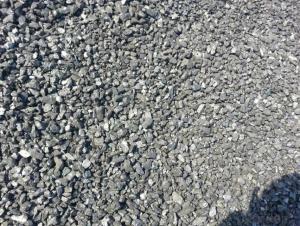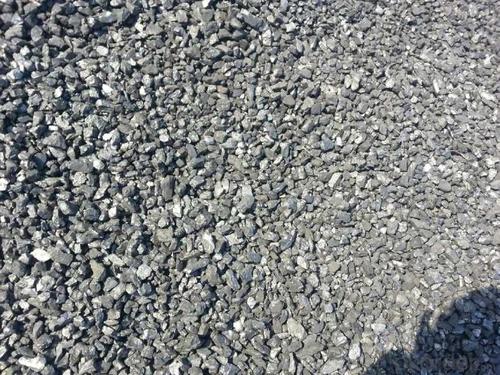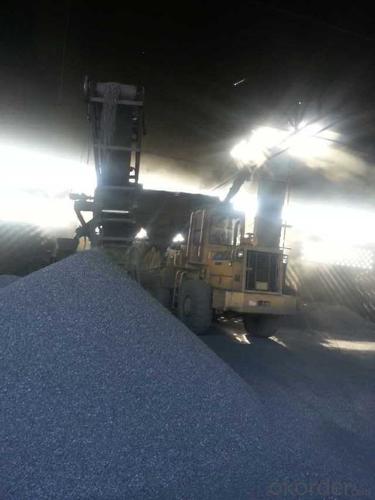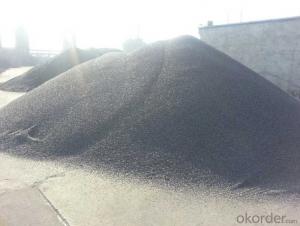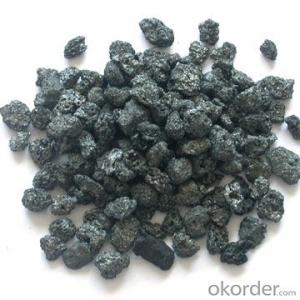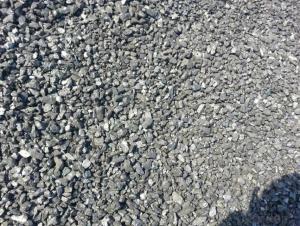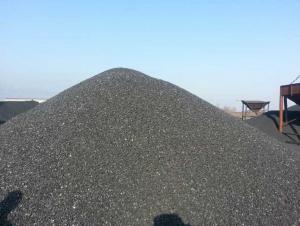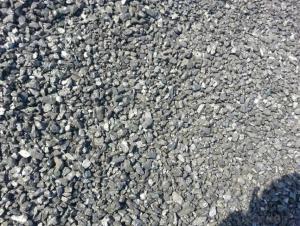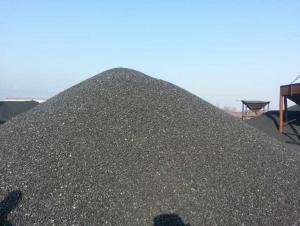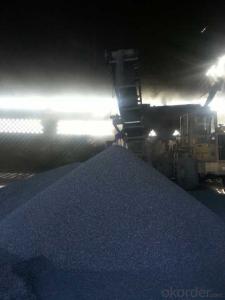Recarburizer FC90-95 with good and stable quality
- Loading Port:
- Tianjin
- Payment Terms:
- TT OR LC
- Min Order Qty:
- 20 m.t.
- Supply Capability:
- 5000 m.t./month
OKorder Service Pledge
OKorder Financial Service
You Might Also Like
Recarburizer FC90-95 with good and stable quality
Packaging & Delivery
25kgs/50kgs/1ton per bag or as buyer's request
Recarburizer FC90-95 with good and stable quality
Specifications
Calcined Anthracite
Fixed carbon: 90%-95%
S: 0.5% max
Size: 0-3. 3-5.3-15 or as request
Recarburizer FC90-95 with good and stable quality
It used the high quality anthracite as raw materials through high temperature calcined at over 2000 by the DC electric calciner with results in eliminating the moisture and volatile matter from anthracite efficiently, improving the density and the electric conductivity and strengthening the mechanical strength and anti-oxidation. It has good characteristics with low ash, low resistvity, low sulphur, high carbon and high density. It is the best material for high quality carbon products.
Recarburizer FC90-95 with good and stable quality
Advantage and competitive of caclined anthracite:
1. strong supply capability
2. fast transportation
3. lower and reasonable price for your reference
4.low sulphur, low ash
5.fixed carbon:95% -90%
6..sulphur:lower than 0.3%
Recarburizer FC90-95 with good and stable quality
General Specification of Calcined Anthracite:
| FC | 95 | 94 | 93 | 92 | 90 |
| ASH | 4 | 5 | 6 | 6.5 | 8.5 |
| V.M. | 1 | 1 | 1 | 1.5 | 1.5 |
| S | 0.3 | 0.3 | 0.3 | 0.35 | 0.35 |
| MOISTURE | 0.5 | 0.5 | 0.5 | 0.5 | 0.5 |
Pictures


FAQ:
Recarburizer FC90-95 with good and stable quality
Why we adopt carbon additive?
Carbon Additives used as additive in steel making process. It made from well-selected Tai Xi anthracite which is low in content of ash, sulphur, phosphorus, high heat productivity, high chemically activation.
Mainly industry property of it is: instead of traditional pertroleum coal of Carbon Additives, reduce the cost of steelmaking.
- Q: What is the starting temperature and final forging temperature of carbon steel?
- The forging temperature range should be as wide as possible, to reduce forging times, improve productivity.1. initial forging temperatureInitial forging temperature is blank began forging temperature should be understood as the highest heating temperature allows steel or alloy in the heating furnace. The furnace before removing from the blank to the forging equipment to forging blank, blank size according to the delivery method and heating furnace and forging a distance between the equipment, there are a few blank tens of degrees of temperature drop. Therefore, really began forging a low temperature, the initial forging blank before, should try to reduce the temperature drop.
- Q: What are the properties of carbon-based textiles?
- Carbon-based textiles offer several distinct advantages in different applications. To begin with, they demonstrate exceptional strength and durability. Renowned for their high tensile strength, carbon-based textiles can resist stretching and tearing, enabling them to withstand harsh conditions and maintain their integrity over time. Moreover, these textiles possess excellent thermal conductivity, efficiently managing heat. This quality proves beneficial in industries like aerospace, automotive, and electronics, where effective heat dissipation is crucial to prevent system failures. Additionally, carbon textiles exhibit remarkable resistance to chemical corrosion, remaining structurally intact even when exposed to various chemicals, acids, and solvents. This resistance makes them ideal for applications in the chemical industry, where contact with corrosive substances is common. Another notable attribute of carbon textiles is their inherent flame resistance. They possess a high resistance to ignition and do not easily propagate flames. Consequently, they find use in environments where fire safety is paramount, such as protective clothing for firefighters and military personnel. Furthermore, carbon-based textiles display good electrical conductivity, making them suitable for electronics and electrical engineering applications. They effectively conduct electricity and dissipate static charges, reducing the risk of electrical malfunctions or damage. Lastly, carbon textiles have a low coefficient of thermal expansion, meaning they undergo minimal expansion or contraction with temperature changes. This property ensures their dimensional stability, guaranteeing that they maintain their shape and size under varying thermal conditions. In conclusion, carbon-based textiles possess a combination of strength, durability, thermal conductivity, chemical resistance, flame resistance, electrical conductivity, and dimensional stability. These properties render them highly versatile and suitable for a wide range of applications across various industries.
- Q: How does carbon dioxide affect textile production?
- Carbon dioxide can have various impacts on textile production. Firstly, the production of carbon dioxide during the manufacturing process of textiles contributes to the overall greenhouse gas emissions, which exacerbates climate change. This can lead to long-term consequences such as extreme weather events, rising temperatures, and sea-level rise, all of which can disrupt the supply chain and production of textiles. Moreover, carbon dioxide emissions from textile production contribute to air pollution, which can have adverse effects on human health. The release of this greenhouse gas can lead to respiratory problems and other respiratory diseases in workers exposed to high levels of carbon dioxide. Additionally, carbon dioxide is often used as a part of the dyeing and finishing process in textile production. This can have negative consequences for the environment as well. Carbon dioxide can contribute to water pollution when it is released into water bodies during the dyeing process, leading to the contamination of water sources and harming aquatic life. Furthermore, the excessive use of carbon dioxide in textile production can also have economic implications. As carbon dioxide is a byproduct of burning fossil fuels, its production is inherently linked to the consumption of non-renewable resources. The reliance on fossil fuels can make textile production vulnerable to price fluctuations, as the cost of carbon dioxide emissions and energy production can vary significantly. To mitigate the negative impacts of carbon dioxide on textile production, various measures can be taken. These include adopting cleaner production techniques and technologies that reduce carbon dioxide emissions, such as the use of renewable energy sources or implementing carbon capture and storage systems. Additionally, investing in sustainable and environmentally-friendly materials, such as organic cotton or recycled fibers, can also help reduce the carbon footprint of textile production. Overall, the reduction of carbon dioxide emissions in textile production is crucial for the industry to become more sustainable and mitigate its environmental and health impacts.
- Q: What are the impacts of carbon emissions on indigenous communities?
- Indigenous communities are greatly affected by carbon emissions, which have significant impacts on their environment, culture, health, and overall well-being. One of the main consequences is the degradation of their traditional lands and natural resources, which are crucial for their livelihoods, including hunting, fishing, and agriculture. The increase in carbon emissions leads to climate change, resulting in changes in temperature, weather patterns, and ecosystems. This disrupts the delicate balance of their ecosystems and makes it more challenging for them to sustain their way of life. The loss of traditional lands and resources also has profound cultural implications for indigenous communities. Their connection to the land is deeply rooted in their identity and spirituality. When their lands are degraded or destroyed due to carbon emissions, it erodes their cultural practices, knowledge, and traditions. This loss of cultural heritage affects not only indigenous communities but also the global society, as their unique knowledge about sustainable land management and conservation practices can offer valuable insights for addressing climate change and protecting the planet. Moreover, carbon emissions contribute to air pollution, which severely impacts the health of indigenous communities. Many indigenous communities live near industrial facilities or fossil fuel extraction sites, leading to increased exposure to pollutants such as particulate matter, sulfur dioxide, and nitrogen oxides. These pollutants cause respiratory illnesses, cardiovascular diseases, and other health issues, disproportionately affecting vulnerable members of these communities, including children and the elderly. In addition to immediate health impacts, the long-term consequences of carbon emissions, such as rising sea levels and extreme weather events, pose further threats to the existence of indigenous communities. Many indigenous communities reside in low-lying coastal areas or remote regions that are more susceptible to the effects of climate change, including coastal erosion, flooding, and loss of traditional food sources. These changes not only disrupt their way of life but also force them to consider relocation, resulting in the loss of their cultural identity and connection to their ancestral lands. Addressing carbon emissions and mitigating climate change is crucial for the well-being and survival of indigenous communities. It involves recognizing their rights to their traditional lands, resources, and self-determination, as well as involving them in decision-making processes regarding environmental conservation. Supporting sustainable development projects that prioritize local needs and indigenous knowledge can help foster resilient communities that can adapt to the changing climate. Ultimately, by reducing carbon emissions and protecting the environment, we can preserve the cultural diversity and invaluable contributions of indigenous communities for future generations.
- Q: How does carbon affect the water cycle?
- Carbon affects the water cycle primarily through the process of photosynthesis, where plants and algae absorb carbon dioxide from the atmosphere and release oxygen. This process not only regulates the carbon dioxide levels in the atmosphere, but also influences the temperature and precipitation patterns, subsequently impacting the water cycle. Additionally, carbon dioxide dissolves in water, forming carbonic acid, which can alter the pH levels of water bodies and potentially affect aquatic life and the overall balance of the water cycle.
- Q: How to distinguish carbon rods to identify carbon fishing rods?
- I'm also waiting to learn! It seems all very busy, the masters are not on-line
- Q: What is carbon dioxide?
- Carbon dioxide (CO2) is a colorless and odorless gas composed of one carbon atom bonded to two oxygen atoms. It is naturally present in the Earth's atmosphere and is also produced by human activities such as burning fossil fuels and deforestation. Carbon dioxide plays a crucial role in the Earth's carbon cycle and is a greenhouse gas, contributing to global warming and climate change.
- Q: How dnf advanced carbon ashes?
- Mall has sold, and sometimes activities, and now there is no
- Q: How is carbon dioxide formed?
- Carbon dioxide is formed through various natural and human activities. It is naturally produced by the respiration of animals, the decay of organic matter, and volcanic eruptions. Additionally, human activities such as the burning of fossil fuels, deforestation, and industrial processes also contribute to the formation of carbon dioxide.
- Q: What is the significance of the determination of total organic carbon in purified water?
- Purified water represents the total amount of organic matter in water by carbon content. It is an important indicator of water quality. The detection of total organic carbon in water is an important item for the detection of pharmaceutical water. Inspection item 2005 edition test item [1] character: This product is colorless and tasteless clear liquid. Check: pH, take this product 10ml, plus methyl red indicator liquid 2 drops, may not show red; another take 10ml, add bromine, thymol blue, indicating liquid 5 drops, may not show blue. Chloride, sulfate and calcium salt were taken in three test tubes, each with 50ml.
Send your message to us
Recarburizer FC90-95 with good and stable quality
- Loading Port:
- Tianjin
- Payment Terms:
- TT OR LC
- Min Order Qty:
- 20 m.t.
- Supply Capability:
- 5000 m.t./month
OKorder Service Pledge
OKorder Financial Service
Similar products
Hot products
Hot Searches
